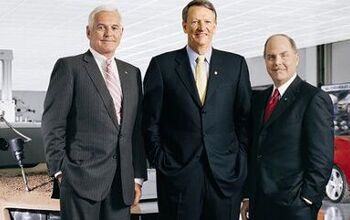General Motors Death Watch 233: Rick Wagoner is a Secret Alien
I once attended a seminar on alien abduction hypnotherapy. When we got to the Q&A bit, I was flabbergasted by the audience’s enquiries. “What do you do if the alien has been in contact with a departed spirit who knew the victim, and used their influence to prevent hypnosis?” “I’d hypnotize the spirit first,” the therapist responded, without batting an eye. Suddenly, I felt very, very alone. Surely, I wasn’t the only person amongst hundreds who thought the whole thing was a patently ridiculous scam. I got that same queasy feeling today, watching my so-called colleagues questioning GM CEO Rick Wagoner about the company’s viability plan. Surely someone would point out that the whole thing is nothing but a patently ridiculous scam. Sigh. Right, let’s get to it then . . .
The 2009-2014 Restructuring Plan—as GM would prefer it called—is 117 pages long. With the help of TTAC’s crack spreadsheet busters, I could engage in a critical analysis of the automaker’s sales projections, cash flow estimates, cost savings, capital spending allocations, debt reduction plans, etc. But that would be like discussing alien breeding habits, and the meaning and use of anal probes. Yes, they did go there. But let’s not.
We’re all rational human beings. We know what GM has to do to stay in business or, let’s go wild, make enough money to pay back the $34b “investment” dragooned from taxpayers by D.C. debt addicts. GM has to take in more money than they spend.
In other words (if other words be necessary), GM has to build something profitable and then sell a shitload of it/them. Those of us with even a passing knowledge of the industry’s recent history and GM’s place within it know that’s just not going to happen. The company’s been outmaneuvered on every front: model, brand, company. Sales, brand share, overall market share. Game, set, match.
Suffice it to say, if the artist once known as the world’s largest automaker knew how to build profitable products, it wouldn’t be begging for one more hit on the federal crack pipe. Ipso facto.
So what makes GM think that this time, it’ll be different?
“Take a look at the products we can do,” Wagoner asserted at the end of the post-$34b PR bomb drop press conference. We haven’t done it a lot, but we can do it, because we kinda did it, a bit, here and there.
For some reason, Wagoner didn’t mention any specific products. Not the Chevrolet Malibu. Cadillac CTS. Pontiac . . . uh . . . . Saying that, I think he mentioned the electric/gas plug-in hybrid Chevrolet Volt at some point, but no one’s buying that. Literally.
OK. Turn to page 63, Appendix D: “Future Product Launches.” Holy shit! “This page has been left intentionally blank.” Surely, they’re not—I mean, they wouldn’t—dedicate themselves to improving what they have instead of chasing The Next Big Thing? After all, on page 16, GM promises to reduce the total number of brands from nine to five, and cut nameplates from 51 to 36.
You weren’t fooled for a second, were you?
Starting on page 64, we get one picture per page of GM’s latest crop of turnaround machines: the aforementioned Chevy Volt, Cadillac CTS Coupe (didn’t they cancel that?), Cadillac CTS Sportwagen (har har), Chevrolet Cruze (didn’t they . . . oh, right, import), Chevrolet Camaro (’nuff said, already), Chevrolet Equinox, new Buick LaCrosse (yes they already make one) and new Cadillac SRX.
Estimated production? Break even point? Profit per vehicle? Nope. But the document lists the most fuel efficient powertrain that will be available—if not the highway miles it will deliver.
Now, page 72. Appendix E gives us bullet points re: GM’s all-important rejigged brand strategy. HUMMER, Saturn and Saab are obvious by their absence. Once that pesky troika of red ink spewers is strategic reviewed out of existence, GM will have four core brands in three sales channels.
You lost me. Let’s try that again. Chevrolet, Buick, GMC and Cadillac will be sold at Chevrolet, Buick-Pontiac-GMC, and Cadillac dealers.
You noticed that did you? Pontiac is now a “niche” brand; it’s only kinda core. More importantly, GM is finally identifying each brand’s market position. Chevrolet = Expressive value. Buick = Sophisticated Quality, Luxury and Craftsmanship. Pontiac = Youthful and Sporty. GMC = Engineering Excellence with Capability and Functionality. Cadillac = Performance Luxury with Aspirational Appeal.
So, how’s that going? I only ask because it’s not. The chances of it suddenly working out for the cash-strapped automaker are about as high as they were before RIck Wagoner guided GM from a death spiral into a nose first landing. Which reminds me . . .
I collared the alien abduction specialist after the seminar. An artist’s impression of a crashed extra-terrestrial spacecraft filled the screen behind him. “What if there aren’t aliens?” I asked the hypnotist, hypothetically. “What if you aren’t really standing there?” he replied. Within seconds, I wasn’t. Unfortunately, when it comes to GM, US taxpayers don’t have that option.
More by Robert Farago
Latest Car Reviews
Read moreLatest Product Reviews
Read moreRecent Comments
- EBFlex *Battery material sourced using child slave labor is exempt. Because child slave labor is A-OK when you're virtue signaling.
- Jalop1991 Watch us find out that the VW diesel engines were filled with slave labor parts, in the middle of Dieselgate.
- Bkojote This is actually a huge problem because it's often 4-5 levels down on the supply chain and goods are 'snuck' in to larger component systems. While a lot of these components don't make it to US imported vehicles, they're often used by the chinese subsidiaries.
- Jeff People complain about there not being enough charging infrastructure. This is a good start with Buc-ee's. I have never been to a Buc-ee's but the next time I see one on the road I will stop and take a look.
- Bd2 Visiting a Bucees at least has made me want to see WallDrug at least once before I leave this earth to the great Telluride in the sky.


































Comments
Join the conversation
Rick won't leave until he will be remembered as the guy who saved GM. By that time the company may have just a 15% marketshare.